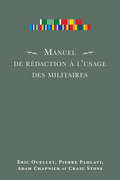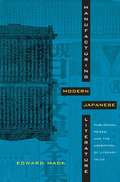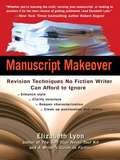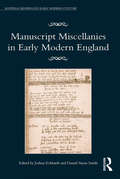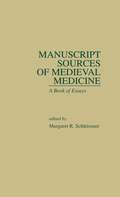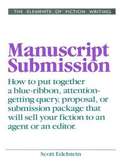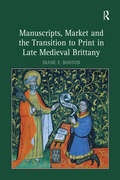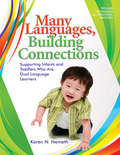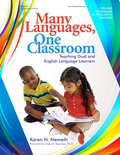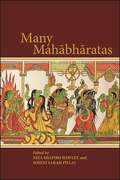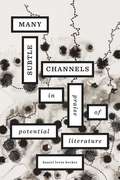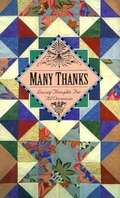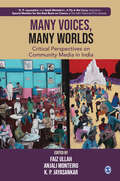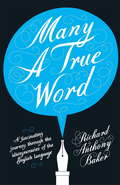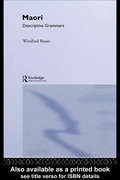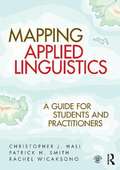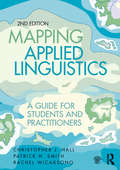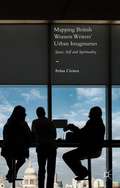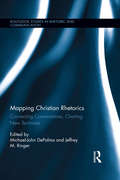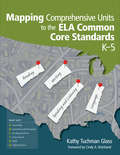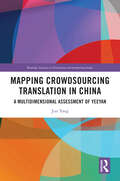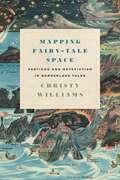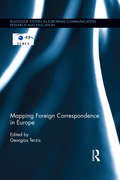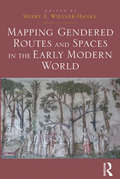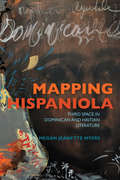- Table View
- List View
Manuel de rédaction à l’usage des militaires
by Adam Chapnick Craig Stone Éric Ouellet Pierre PahlaviLe Manuel de rédaction à l’usage des militaires est un guide de rédaction qui s’adresse aux membres des forces armées appelés à rédiger des textes de qualité dans un style soutenu pour un lectorat militaire averti. Au-delà de l’art de rédiger de manière précise et convaincante, ce manuel fait valoir auprès des militaires gradés qu’une bonne compréhension des rudiments de la rédaction contribue à leur propre efficacité dans leur fonction, tout particulièrement lorsqu’ils accèdent aux rangs supérieurs de l’institution. Le Manuel de rédaction à l’usage des militaires a été développé de manière à habiliter les militaires gradés à aller au-delà de la simple rédaction d’une note de service pour réussir une rédaction plus élaborée qui intègre les règles « universelles » des travaux universitaires. Il aborde divers aspects de la rédaction : l’importance de parfaire ses connaissances et ses habiletés en rédaction; le processus de rédaction et les différences selon le style adopté et les lectorats visés; la méthodologie et la recherche; les questions éthiques comme le plagiat; et les difficultés et les pièges les plus courants. Le dernier chapitre s’avère novateur dans la mesure où il porte sur la façon dont les membres des forces armées peuvent s’inspirer de leur expérience militaire comme élément porteur d’un exercice de rédaction. Des exemples précis, toujours avec un lectorat militaire à l’esprit, complètent le texte. Le Manuel de rédaction à l’usage des militaires est unique en son genre puisqu’il a été conçu spécifiquement à l’intention du personnel des forces armées. Les auteurs Éric Ouellet et Pierre Pahlavi et les collaborateurs Adam Chapnik et Craig Stone sont des professeurs chevronnés qui enseignent au Collège des Forces canadiennes de Toronto. Ce livre, taillé sur mesure pour répondre à un besoin précis, est donc appelé à devenir une référence incontournable dans ce milieu, à l’instar de sa version originale en langue anglaise, Academic Writing for Military Personnel, d’Adam Chapnik et Craig Stone. - Ce livre est publié en français
Manufacturing Modern Japanese Literature: Publishing, Prizes, and the Ascription of Literary Value
by Edward MackEmphasizing how modes of book production, promotion, and consumption shape ideas of literary value, Edward Mack examines the role of Japan's publishing industry in defining modern Japanese literature. In the late nineteenth century and early twentieth, as cultural and economic power consolidated in Tokyo, the city's literary and publishing elites came to dominate the dissemination and preservation of Japanese literature. As Mack explains, they conferred cultural value on particular works by creating prizes and multivolume anthologies that signaled literary merit. One such anthology, the Complete Works of Contemporary Japanese Literature (published between 1926 and 1931), provided many readers with their first experience of selected texts designated as modern Japanese literature. The low price of one yen per volume allowed the series to reach hundreds of thousands of readers. An early prize for modern Japanese literature, the annual Akutagawa Prize, first awarded in 1935, became the country's highest-profile literary award. Mack chronicles the history of book production and consumption in Japan, showing how advances in technology, the expansion of a market for literary commodities, and the development of an extensive reading community enabled phenomena such as the Complete Works of Contemporary Japanese Literature and the Akutagawa Prize to manufacture the very concept of modern Japanese literature.
Manuscript Makeover
by Elizabeth LyonProfessional editor and author Elizabeth Lyon offers aspiring novelists the guidance and instruction they need to write and edit well-crafted and compelling stories that will stand out from the competition and attract the attention of agents and publishers, including: - Stand-out style techniques, from accessing an authentic voice to applying techniques of "wordsmithing" that transform prose - How to rewrite characterization for dimensionality, a universal need, and theme - Adjustment suggestions to match the prose style and structure of specific genres - Correct grammar, punctuation, spelling, and style - Strategies to strengthen story beginnings and endings - Methods for increasing plot stakes, creating movement, and adjusting pace for maximum suspense
Manuscript Miscellanies in Early Modern England (Material Readings in Early Modern Culture)
by Joshua Eckhardt Daniel Starza SmithPerhaps more than any other kind of book, manuscript miscellanies require a complex and ’material’ reading strategy. This collection of essays engages the renewed and expanding interest in early modern English miscellanies, anthologies, and other compilations. Manuscript Miscellanies in Early Modern England models and refines the study of these complicated collections. Several of its contributors question and redefine the terms we use to describe miscellanies and anthologies. Two senior scholars correct the misidentification of a scribe and, in so doing, uncover evidence of a Catholic, probably Jesuit, priest and community in a trio of manuscripts. Additional contributors show compilers interpreting, attributing, and arranging texts, as well as passively accepting others’ editorial decisions. While manuscript verse miscellanies remain appropriately central to the collection, several essays also involve print and prose, ranging from letters to sermons and even political prophesies. Using extensive textual and bibliographical evidence, the collection offers stimulating new readings of literature, politics, and religion in the early modern period, and promises to make important interventions in academic studies of the history of the book.
Manuscript Sources of Medieval Medicine: A Book of Essays (Medieval Casebooks Series #8)
by Margaret R. SchleissnerIn these new essays leading European and North American scholars of medieval medicine focus on manuscripts and their transmission and demonstrate how medievalists in all disciplines can profit by studying the primary medical sources rather than relying on the secondary literature. It is only through the study of actual medical manuscripts that context and audience can be discussed adequately. The lead essay by Bernard Schnell, Prolegomena to a History of Medieval German Medical Literature: The Twelfth Century, clarifies methodological principles for this literary sociology and examines the current state of research in the study of manuscript transmission. The remaining essays discuss either manuscripts by a single author or paradigmatic manuscripts within a single national tradition. Until all the basic sources in medieval texts are uncovered and a survey is made, this volume will stand as an overview of the field.
Manuscript Submission
by Scott EdelsteinPart of the Elements of Fiction Writing Series, this book will help writer improve their work. It features quality instruction from award-winning authors and focuses on a key facet of fiction writing, making it easy for writers to find the specific guidance they're looking for.
Manuscripts, Market and the Transition to Print in Late Medieval Brittany
by Diane E. BootonManuscripts, Market and the Transition to Print in Late Medieval Brittany surveys the production and marketing of non-monastic manuscripts and printed books over 150 years in late medieval Brittany, from the accession of the Montfort family to the ducal crown in 1364 to the duchy's formal assimilation by France in 1532. Brittany, as elsewhere, experienced the shift of manuscript production from monasteries to lay scriptoria and from rural settings to urban centers, as the motivation for copying the word in ink on parchment evolved from divine meditation to personal profit. Through her analysis of the physical aspects of Breton manuscripts and books, parchment and paper, textual layouts, scripts and typography, illumination and illustration, Diane Booton exposes previously unexplored connections between the tangible cultural artifacts and the society that produced, acquired and valued them. Innovatively, Booton's discussion incorporates archival research into the prices, wages and commissions associated with the manufacture of the works under discussion to shed new light on their economic and personal value.
Many Languages, Building Connections: Supporting Infants and Toddlers Who Are Dual Language Learners
by Karen NemethAll infants and toddlers need experiences that nurture, support, and teach their home language and culture. Language is a vital component of early experiences well before a child can say his first word. Infants and toddlers whose families come from diverse backgrounds and speak different languages are appearing in all kinds of early care and learning settings in growing numbers. Even the most experienced caregiver can feel a bit unsure about meeting the unique needs of infants and toddlers from different language backgrounds.Many Languages, Building Connections outlines adaptable strategies that caregivers of children younger than the age of three need to feel confident that they know how language develops, how cultural differences can come into play, and how to assess an individual child's situation to provide appropriate support. From welcoming diverse families and engaging them to participate in a child care program to creating nurturing communities that value and support each child's home language while also fostering English acquisition, the helpful strategies in Many Languages, Building Connections will prepare caregivers for the diverse reality they encounter in their work.
Many Languages, One Classroom: Teaching Dual and English Language Learners
by Karen NemethIn classrooms across the country, teachers are encountering more children who are learning English, come from diverse backgrounds, and who speak a variety of languages. As challenging as this may be, a preschool teacher's goal remains the same: to welcome all children and give them the best possible start in education and in life. Even the most experienced teacher can feel a bit unsure about meeting the unique needs of children from different language backgrounds. Many Languages, One Classroom applies the latest information about best practices to all aspects of a preschool program. From using lists of key words and visual aids to using body language and gestures, the strategies you will find in this book are adaptable and easy to put into practice. Designed to fit any preschool curriculum, Many Languages, One Classroom addresses state standards and benchmarks of standard quality programming. Organized by interest areas and times of the day, you'll find everything you need to help English language learners during dramatic play, outdoor play, reading, science, blocks, and circle time.
Many Mahābhāratas (SUNY series in Hindu Studies)
by Nell Shapiro Hawley Sohini Sarah PillaiA major contribution to the study of South Asian literature, offering a landmark view of Mahābhārata studies.Many Mahābhāratas is an introduction to the spectacular and long-lived diversity of Mahābhārata literature in South Asia. This diversity begins with the Sanskrit Mahābhārata, an early epic poem that narrates the events of a catastrophic fratricidal war. Along the way, it draws in nearly everything else in Hindu mythology, philosophy, and story literature. The magnitude of its scope and the relentless complexity of its worldview primed the Mahābhārata for uncountable tellings in South Asia and beyond. For two thousand years, the instinctive approach to the Mahābhārata has been not to consume it but to create it anew.The many Mahābhāratas of this book come from the first century to the twenty-first. They are composed in nine different languages-Apabhramsha, Bengali, English, Hindi, Kannada, Malayalam, Sanskrit, Tamil, and Telugu. Early chapters illuminate themes of retelling within the Sanskrit Mahābhārata itself, demonstrating that the story's propensity for regeneration emerges from within. The majority of the book, however, reaches far beyond the Sanskrit epic. Readers dive into classical dramas, premodern vernacular poems, regional performance traditions, commentaries, graphic novels, political essays, novels, and contemporary theater productions-all of them Mahābhāratas.Because of its historical and linguistic breadth, its commitment to primary sources, and its exploration of multiplicity and diversity as essential features of the Mahābhārata's long life in South Asia, Many Mahābhāratas constitutes a major contribution to the study of South Asian literature and offers a landmark view of the field of Mahābhārata studies.
Many Subtle Channels: In Praise of Potential Literature
by Daniel Levin BeckerWhat sort of society could bind together Jacques Roubaud, Italo Calvino, Marcel Duchamp, and Raymond Queneau-and Daniel Levin Becker, a young American obsessed with language play? Only the Oulipo, the Paris-based experimental collective founded in 1960 and fated to become one of literature’s quirkiest movements. An international organization of writers, artists, and scientists who embrace formal and procedural constraints to achieve literature’s possibilities, the Oulipo (the French acronym stands for workshop for potential literature) is perhaps best known as the cradle of Georges Perec’s novel A Void, which does not contain the letter e. Drawn to the Oulipo’s mystique, Levin Becker secured a Fulbright grant to study the organization and traveled to Paris. He was eventually offered membership, becoming only the second American to be admitted to the group. From the perspective of a young initiate, the Oulipians and their projects are at once bizarre and utterly compelling. Levin Becker’s love for games, puzzles, and language play is infectious, calling to mind Elif Batuman’s delight in Russian literature in The Possessed. In recent years, the Oulipo has inspired the creation of numerous other collectives: the OuMuPo (a collective of DJs), the OuMaPo (marionette players), the OuBaPo (comic strip artists), the OuFlarfPo (poets who generate poetry with the aid of search engines), and a menagerie of other Ou-X-Pos (workshops for potential something). Levin Becker discusses these and other intriguing developments in this history and personal appreciation of an iconic-and iconoclastic-group.
Many Thanks: Loving Thoughts for All Occasions
by Lisa PalasA collection of well over 100 beautiful, wise and exuberant quotes and verses featuring numerous aspects of thankfulness for love, gifts, family, friendship, nature, contentment, life and more. Reading them is uplifting. They can help you to express thanks to others, or can be shared to spread the pleasure. They are drawn from a variety of sources including historical figures, proverbs, poets, the bible and other religious texts, and from people you may not know but whose thoughts are treasures. From the dust jacket: This book says thank you to friends for their support and goodwill, to family members for their love, and to friends for their undying devotion. Charles Dickens said, A loving heart is the truest wisdom.
Many Voices, Many Worlds: Critical Perspectives on Community Media in India
by Faiz Ullah Anjali Monteiro K. P. JayasankarCommunity media has the potential for deepening democracy by creating spaces for people to raise and discuss their concerns. However, its practice in India tends to be based on top-down decision-making, which is the legacy of the Development Communication paradigms, thus ignoring the creative and transformative possibilities of marginalized community voices. The perspectives in this book, rooted in years of fieldwork experience, by scholars and practitioners of community media, both question and offer alternatives to the dominant paradigms. Many Voices, Many Worlds: Critical Perspectives on Community Media in India is a critical reflection on governance and policymaking, development, disability, knowledge and other social markers in the context of community media. Bringing together different modes of community media—such as video, radio, theatre, information and communication technologies (ICTs) and new media—into a productive conversation with each other, the book focuses on how communities through their communicative practices, negotiate the politics of caste, class, gender, and access to funding and technology.
Many a True Word
by Richard Anthony BakerWhat are the top one hundred words we use the most? How should anchovy, chastisement and tryst be pronounced? How good are you at spelling the most commonly misspelt words and names? For the answers to these andquestions and much more, sit back and let Richard Anthony Baker take you on a journey through the English language.Marvel at the richness of what we derive from French and German; bristle at the words banned in the Daily Telegraph; laugh at the officialese of corporate writers; bone up on our use of language from William Shakespeare (and the Bible) in our day-to-day talk; absorb Richard's master classes on how to win at Scrabble with devastating ease and how to complete cryptic crosswords with impressive alacrity; and test your linguistic agility by trying to answer the five questions which Google puts to job applicants.
Maori (Descriptive Grammars)
by Winifred BauerThis descriptive grammar provides a uniquely comprehensive description of Maori, the East Polynesian language of the indigenous people of New Zealand. Today, the language is under threat and it seems likely that the Maori of the future will differ quite considerably from the Maori of the past.Winifred Bauer offers a wide-ranging and detailed description of the structure of the language, covering syntax, morphology and phonology. Based upon narrative texts and data elicited from older native-speaking consultants and illustrated with a wealth of examples the book will be of interest to both linguistic theoreticians and descriptive linguists, including language typologists.
Mapping Applied Linguistics: A Guide for Students and Practitioners
by Christopher J. Hall Rachel Wicaksono Patrick H SmithMapping Applied Linguistics: A Guide for Students and Practitioners provides an innovative and wide-ranging introduction to the full scope of applied linguistics. Incorporating both socio-cultural and cognitive perspectives, the book maps the diverse and constantly expanding range of theories, methods and issues faced by students and practitioners alike. Practically oriented and ideally suited to students new to the subject area, the book provides in-depth coverage of: language teaching and education, literacy and language disorders language variation and world Englishes language policy and planning lexicography and forensic linguistics multilingualism and translation. Including real data and international examples, the book features further reading and exercises in each chapter, fieldwork suggestions and a full glossary of key terms. An interactive Companion Website also provides a wealth of additional resources. This book will be essential reading for students studying applied linguistics, TESOL, general linguistics, and education at the advanced undergraduate or master's degree level. It is also the ideal gateway for practitioners to better understand the wider scope of their work.
Mapping Applied Linguistics: A Guide for Students and Practitioners
by Christopher J. Hall Rachel Wicaksono Patrick H. SmithMapping Applied Linguistics: A guide for students and practitioners, second edition, provides a newly updated, wide-ranging introduction to the full scope of applied linguistics. This innovative book maps the diverse and constantly expanding range of theories, methods and issues faced by students and practitioners around the world, integrating both sociocultural and cognitive perspectives. Practically oriented and ideally suited to students new to the discipline, Mapping Applied Linguistics provides in-depth coverage of: multilingualism, language variation and Global Englishes literacy, language teaching and bilingual education discourse analysis language policy and planning lexicography and translation language pathology and forensic linguistics The new second edition features contemporary examples of global applied linguistics research and practice, and includes updated further reading and new fieldwork suggestions for each chapter. The companion website at cw.routledge.com/textbooks/hall provides a wealth of additional learning material, including activities, flashcards and links to the latest online resources. Mapping Applied Linguistics is essential reading for students studying applied linguistics, TESOL, general linguistics and language and literacy education at the advanced undergraduate or master’s degree level. It also provides a gateway for practitioners and specialists seeking to better understand the wider scope of their work.
Mapping British Women Writers' Urban Imaginaries: Space, Self and Spirituality
by Arina CirsteaThis study provides an alternative to the postmodern tradition of writing about the city by exploring spatialized constructions of gender and spiritual identity through an integrative framework based on insights from Bachelard's topoanalysis, psychogeography, feminist cultural theory and comparative literature and religion.
Mapping Christian Rhetorics: Connecting Conversations, Charting New Territories (Routledge Studies in Rhetoric and Communication)
by Jeffrey M. Ringer Michael-John DePalmaThe continued importance of Christian rhetorics in political, social, pedagogical, and civic affairs suggests that such rhetorics not only belong on the map of rhetorical studies, but are indeed essential to the geography of rhetorical studies in the twenty-first century. This collection argues that concerning ourselves with religious rhetorics in general and Christian rhetorics in particular tells us something about rhetoric itself—its boundaries, its characteristics, its functionings. In assembling original research on the intersections of rhetoric and Christianity from prominent and emerging scholars, Mapping Christian Rhetorics seeks to locate religion more centrally within the geography of rhetorical studies in the twenty-first century. It does so by acknowledging work on Christian rhetorics that has been overlooked or ignored; connecting domains of knowledge and research areas pertaining to Christian rhetorics that may remain disconnected or under connected; and charting new avenues of inquiry about Christian rhetorics that might invigorate theory-building, teaching, research, and civic engagement. In dividing the terrain of Christian rhetorics into four categories—theory, education, methodology, and civic engagement—Mapping Christian Rhetorics aims to foster connections among these areas of inquiry and spur future future collaboration between scholars of religious rhetoric in a range of research areas.
Mapping Comprehensive Units to the ELA Common Core Standards, K–5
by Kathy Tuchman GlassA GPS for connecting standards to lessons Translating the Common Core State Standards into an effective curriculum is at the top of many educators’ to-do list, and this book shows you how. This text familiarizes teachers and curriculum designers with the key points of the ELA core standards and demonstrates how to design effective curriculum units to align with them. The author provides practical and accessible tools for developing a map and for making the important connections among all unit map components, including differentiated instruction. Also included are: A rationale for each of the ELA common core standards An overview of the key benefits Reproducible templates and examples of unit curriculum maps
Mapping Crowdsourcing Translation in China: A Multidimensional Assessment of Yeeyan (Routledge Advances in Translation and Interpreting Studies)
by Jun YangYang explores the use of crowdsourcing in translation within the Chinese context, focusing on Yeeyan – the largest online translation community in China. As one of the world’s largest markets for language content consumption, China experiences significant demand for translation services. Yeeyan, a pioneer among amateur translation communities in China, offers an autonomous environment where the public collectively determines the content they wish to import from foreign languages.The book conducts a holistic evaluation of crowdsourcing translation using a multidimensional analytical framework, emphasising the interrelations among agents, processes, products, and crowdsourcing environments. Using the Yeeyan community as a case study, the book investigates the motivations behind participation in Yeeyan, the quality of translations produced, the extent to which this quality can be controlled, and how learning occurs through their participation. The analysis includes the two primary types of projects facilitated by Yeeyan – article translation for knowledge-sharing and book translation for commercial publication. Additionally, Yang explores the emerging field of crisis translation - assessing the applications of crowdsourcing in disaster contexts and exploring the ethical implications involved. Drawing on empirically informed results, the book proposes recommendations for the effective design and organisation of crowdsourcing translation projects and elucidates how such initiatives can be optimally utilised in both translation production and translation training endeavours.This book is a valuable contribution to the field of translation studies, offering a detailed examination of crowdsourcing translations and the participatory culture of the Chinese internet.
Mapping Fairy-Tale Space: Pastiche and Metafiction in Borderless Tales (Series in Fairy-Tale Studies)
by Prof. Christy WilliamsMapping Fairy-Tale Space: Pastiche and Metafiction in Borderless Tales by Christy Williams uses the metaphor of mapping to examine the narrative strategies employed in popular twenty-first-century fairy tales. It analyzes the television shows Once Upon a Time and Secret Garden (a Korean drama), the young-adult novel series The Lunar Chronicles, the Indexing serial novels, and three experimental short works of fiction by Kelly Link. Some of these texts reconfigure well-known fairy tales by combining individual tales into a single storyworld; others self-referentially turn to fairy tales for guidance. These contemporary tales have at their center a crisis about the relevance and sustainability of fairy tales, and Williams argues that they both engage the fairy tale as a relevant genre and remake it to create a new kind of fairy tale. Mapping Fairy-Tale Space is divided into two parts. Part 1 analyzes fairy-tale texts that collapse multiple distinct fairy tales so they inhabit the same storyworld, transforming the fairy-tale genre into a fictional geography of borderless tales. Williams examines the complex narrative restructuring enabled by this form of mash-up and expands postmodern arguments to suggest that fairy-tale pastiche is a critical mode of retelling that celebrates the fairy-tale genre while it critiques outdated ideological constructs. Part 2 analyzes the metaphoric use of fairy tales as maps, or guides, for lived experience. In these texts, characters use fairy tales both to navigate and to circumvent their own situations, but the tales are ineffectual maps until the characters chart different paths and endings for themselves or reject the tales as maps altogether. Williams focuses on how inventive narrative and visual storytelling techniques enable metafictional commentary on fairy tales in the texts themselves. Mapping Fairy-Tale Space argues that in remaking the fairy-tale genre, these texts do not so much chart unexplored territory as they approach existing fairy-tale space from new directions, remapping the genre as our collective use of fairy tales changes. Students and scholars of fairy-tale and media studies will welcome this fresh approach.
Mapping Foreign Correspondence in Europe (Routledge Studies in European Communication Research and Education)
by Georgios TerzisThe book studies the current trends of foreign correspondence in Europe. The EU’s expansion has had abundant effects on news coverage and some of the European capitals have become home to the biggest international press corps in world. So, who are these "professional strangers" stationed in Europe and how do they try to make their stories, that are clearly important in today’s interconnected world, interesting for viewers and readers?This book represents the first Pan-European study of foreign correspondents and their reporting. It includes chapters from 27 countries, and it aims to study them and the direction, flow and pattern of their coverage, as well as answer questions regarding the impact of new technologies on the quantity, frequency and speed of their coverage. Do more sophisticated communications tools yield better international news coverage of Europe? Or does the audience’s increasing apathy and the downsizing of the foreign bureaus offset these advances? And how do the seemingly unstoppable media trends of convergence, commercialization, concentration, and globalization affect the way Europe and individual European countries are reported?
Mapping Gendered Routes and Spaces in the Early Modern World
by Merry E. Wiesner-HanksHow did gender figure in understandings of spatial realms, from the inner spaces of the body to the furthest reaches of the globe? How did women situate themselves in the early modern world, and how did they move through it, in both real and imaginary locations? How do new disciplinary and geographic connections shape the ways we think about the early modern world, and the role of women and men in it? These are the questions that guide this volume, which includes articles by a select group of scholars from many disciplines: Art History, Comparative Literature, English, German, History, Landscape Architecture, Music, and Women's Studies. Each essay reaches across fields, and several are written by interdisciplinary groups of authors. The essays also focus on many different places, including Rome, Amsterdam, London, and Paris, and on texts and images that crossed the Atlantic and the Mediterranean, or that portrayed real and imagined people who did. Many essays investigate topics key to the ’spatial turn’ in various disciplines, such as borders and their permeability, actual and metaphorical spatial crossings, travel and displacement, and the built environment.
Mapping Hispaniola: Third Space in Dominican and Haitian Literature (New World Studies)
by Megan Jeanette MyersBecause of their respective histories of colonization and independence, the Spanish-speaking Dominican Republic has developed into the largest economy of the Caribbean, while Haiti, occupying the western side of their shared island of Hispaniola, has become one of the poorest countries in the Americas. While some scholars have pointed to such disparities as definitive of the island’s literature, Megan Jeanette Myers challenges this reduction by considering how certain literary texts confront the dominant and, at times, exaggerated anti-Haitian Dominican ideology.Myers examines the antagonistic portrayal of the two nations—from the anti-Haitian rhetoric of the intellectual elites of Dominican dictator Rafael Trujillo’s rule to the writings of Julia Alvarez, Junot Díaz, and others of the Haitian diaspora—endeavoring to reposition Haiti on the literary map of the Dominican Republic and beyond. Focusing on representations of the Haitian-Dominican dynamic that veer from the dominant history, Mapping Hispaniola disrupts the "magnification" and repetition of a Dominican anti-Haitian narrative.
